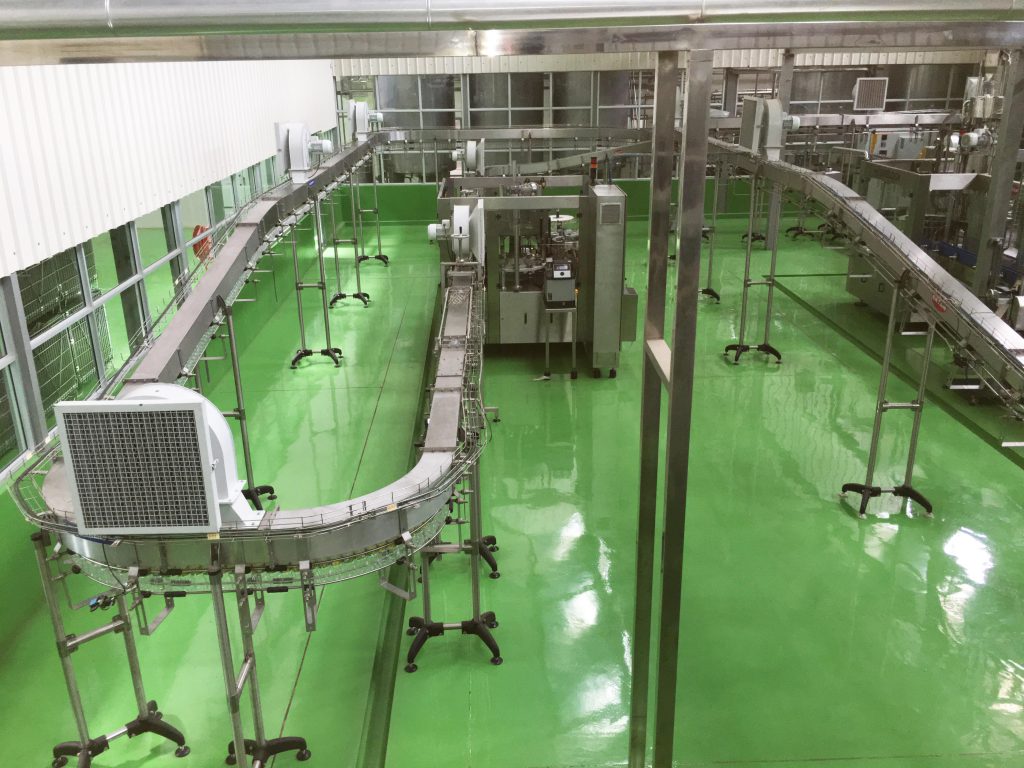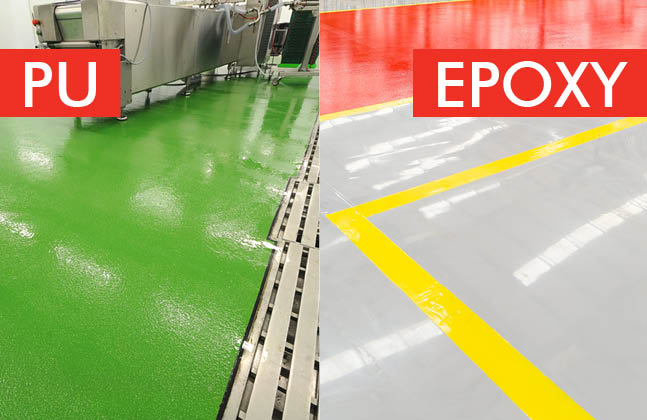Let’s talk about flooring:
We walk on them, we drop things on them, we work on them, so when it comes to future-proofing a food facility floor, it’s important to choose materials specifically designed to tackle food industry challenges!
Hardwearing resin systems, epoxy and polyurethane, are typically used for busy food plants that subject their floors to physical impacts, point loading and traffic from equipment such as heavily laden pallet trolleys and forklift trucks. Of course, all of these factors can cause damage to a floor finish and if the coating is applied too thinly; hard to clean cracks can appear in the finish, increasing the risk of unwanted bacteria.
To prevent these risks from occurring, businesses, manufacturers and architects are continually on the look out for protective floor systems such as epoxy or polyurethane. Although they are often talked about as the same product, they are actually two different types of floor coatings with their own distinct properties. To make sure you’re choosing the right system for you, we thought we’d compare the two.
What do they cost?
Whilst a polyurethane system will initially cost more compared to an epoxy, it is far more cost effective in the long term. In fact, the lifespan of the PU system is roughly double that of the epoxy, clocking an impressive ten-year’s compared to the epoxy’s five. PU systems also benefit from their increased wear, abrasion and impact resistance properties.
What resistance do they offer?
In general, epoxy resins offer limited resistance to the organic acids that are found in large quantity of food and drink produce, whereas polyurethane systems boast unrivalled resistance to corrosion, inorganic, alkalis, organic alkalis and solvents.

This HACCP International certified, polyurethane floor screed creates an exceptionally durable surface and has the antimicrobial additive Polygiene® incorporated within it.
Are they tolerant to heat?
Polyurethanes provide superior heat, cold and thermal shock tolerance. Epoxies on the other hand are naturally more rigid and are able to move with a concrete substrate when exposed to heat fluctuations. To exemplify this, a standard two-pack, 100% solids epoxy coating, has a heat resistance of up to 65 °C, whereas some PU systems can tolerate 120°C.
This thermal shock resistance is a great benefit in food and beverage facilities where extreme temperature changes often occur on a daily basis. For example when a room is steam cleaned; in areas where hot oven doors are being opened or where there is the possibility of boiling substances spilling onto the floor.

This polyurethane floor provides superior heat resistance of up to 120°C – ideal for food and beverage environments as its durable nature enables it to withstand thermal shock from hot ovens, chemical attacks from food by-products and point loading from heavy equipment.

A high-build epoxy resin coating system was used to provide a level and reliable surface that would not deteriorate when faced with constant traffic from pedestrians, wheeled equipment, heavy pallets and fully loaded racks of produce.
How do they compare generally?
Polyurethane floors are generally softer and more elastic compared to the epoxy, giving them better resistance to scratching – ideal for spaces like multi-deck car parks, which experience high levels of foot traffic.
Overall, the qualities of the polyurethane system outweigh those of a roller-applied epoxy coating. Polyurethane is therefore the better choice for food processing companies that work in milk, dairy and cheese production, due to its ability to protect their flooring from organic acids, compared with Epoxies that are likely to experience corrosion and yellowing in these environments.
Which one is recommended for the food industry?
The main difference between this type of material and the epoxy systems is in the molecular structure of the two, which affects how the molecules fuse together during the curing process. Essentially, polyurethanes have a higher cross-link density than epoxies, making them more durable.
In addition, polyurethane floors can offer food producers and processors the opportunity to take hygiene to the next level, by incorporating antimicrobial additives into the resin build up of the floor itself; preventing bacterial growth.
Want to find out more? Find part two of this mini series here or contact one of our Flowcrete experts who will be more than happy to discuss your ideas and project.
16 thoughts on “Epoxy vs. Polyurethane – Which Will You Choose?”
Comments are closed.






Good Info
Thanks Sudhir for your kind comments! Much appreciated, Rebekah
Good Info. I think one should view more actual application videos.
Hi Carl
Many thanks for your comment. If you like application videos, check out our Youtube playlist of resin flooring applications – https://bit.ly/2I0vwcM
Kind regards,
Dan
Great article.very well explained with the help of pictures.You have cleared all my doubts regarding epoxy and polyurethan. Thanks for sharing this informative article.
Now I really love to use polyurethane to furnish my furniture. It’s glossy and water resistant. Much more easy to use rather than epoxy resin. For premium brands of each, the price is similar.
Hello,
If we have done PU flooring, do we need to add 1 few layers of PU coating on top of the PU flooring? Is there any benefit or disadvantage to do PU coating on to of PU flooring?
Hi
That’s a good question. While PU floors tend to be very hardy without any additional sealers or coatings, it can be beneficial to install a PU coating in circumstances where the floor area could benefit from additional protection. For example if the floor is likely to face a substantial amount of heavy impacts, scratches and abrasions, then it might be worthwhile to apply a PU sealer to give it an even more robust finish. Or another example would be in places where the floor is going to be exposed to prolonged periods of intense sunlight which would likely benefit from an aliphatic PU sealer due to the impressive UV resistance properties of this material. If you’re not too sure if your floor area requires this additional protection or not, then have a word with a reputable contractor or supplier with experience in similar flooring projects to gauge their opinion.
Cheers,
Dan
Hi Dan,
Thank you very much for sharing your useful information. It helps me a lot.
BRs,
Siwarak
which is more bonding to concrete epoxy products or polyurethane products
Hi Ayman
Both epoxies and polyurethane coatings bond well to concrete substrates, so long as the concrete has been properly cleaned, prepped and primed. This post looks at this in more detail – http://bit.ly/2D2AHYE
Kind regards,
Dan
Thanks for your article. Can I paint over an already painted concrete floor with either of these paints ?
Hi Katya
Both epoxy and PU floors require a prepped substrate in order to achieve a proper bond. Failing to prep the substrate can result in the new coating peeling and flaking away. For these reason it’s inadvisable to apply either directly onto a painted floor I’m afraid.
Kind regards,
Dan
Reduction of bacterial growth which is vitally important for healthcare facilities, food and beverage plants, and restaurants and both epoxy and polyurethane function in this way. Could the methods of application give the edge to one over the other?
Hi Lee
The methods of application shouldn’t have a discernible impact on bacterial growth. Once cured, both types are easy to clean if onsite bacteria levels during the application process is a concern.
Kind regards,
Dan
we should choose Epoxy or PU on the saturation of the Objected area to apply Epoxy or PU
The Main factors what we should think are Chemical resistance,Heat resistance,UV resistance, Flexibility and abrasion resistance, scratch resistance ,etc